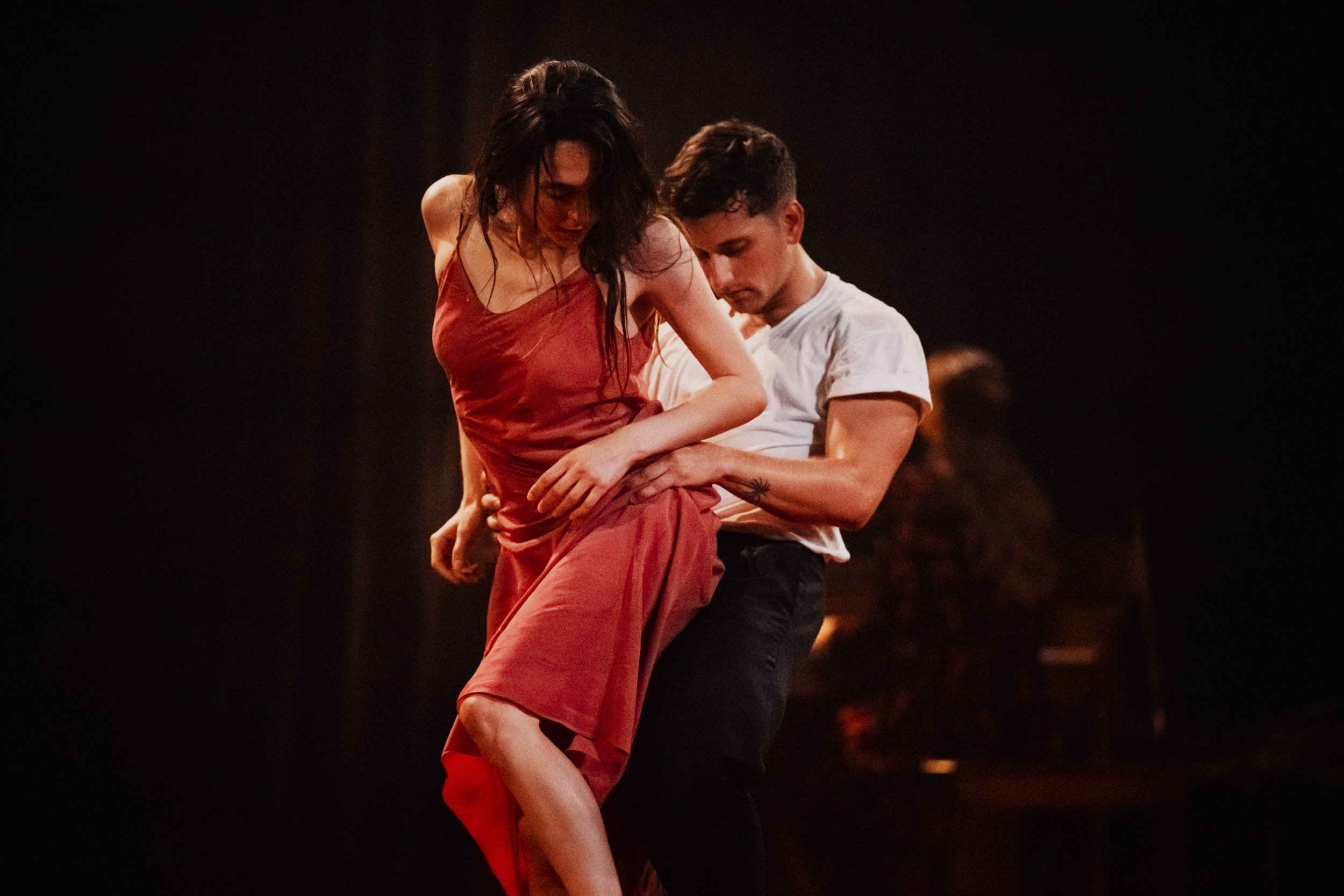Photographs by Josh A. Rose for L.A. Dance Project, 2023
Bobbi Jene Smith and Or Schraiber’s The Missing Mountain hits you first with the scent of foggy mist and then with the crimson sea of wall-to-wall carpet. It’s a one-two punch that has you drunk in its ambience before you’ve even found a place to sit. Two of the dancers are seated at a dining table, another on a couch, one stands by a ladder stage right and another upstage next to a piano carrying a large bouquet of gladioli that fully obscure her face. Hers is the first step. It’s small and fast, bringing her one foot closer to the audience. It will be nearly a minute before she takes another, although the music is woolly and dissonant, making it difficult to track time. Her movements slowly accumulate at a pace that feels nebulous while she expands into the space. It’s a spellbinding opening solo that winds us into a hypnogogic state before it transitions into a romantic pas de deux with a sinewy texture of movement, which suggests that the gravitational pull and atmospheric pressure has shifted in the room.
This is a surreal space occupied by six distinct, archetypal characters who populate our collective unconscious with the specters of an undocumented halcyon era. Daphne Fernberger is a lithesome vessel of femininity whose clarity of movement is as crisp and smooth as her rose-colored silk midi slip. Hope Spears repels off walls, defying gravity one moment and grounding herself consummately the next like an arachnid. Courtney Conovan has limbs as long and fine as her flaxen locks and she is in full control from core to extremity with every small, isolated articulation and every sweeping, full-body conveyance. Lorrin Brubaker is the most understated. He commands without drawing attention to anything in particular and yet he is magnetic in his cool subdue. Jeremy Coachman is a powerhouse chameleon. He is supple and romantic, fierce and formidable, and when you least expect it, he’ll throw in a light, coy wiggle of the ass. A spotlight hits the downstage right corner illuminating an antique standup microphone. Shu Kinouchi in a tuxedo with coattails and thick, red socks reads the weather report in English, punctuating it with mysterious cries in Japanese. He is the master of ceremonies. Equally indignant as he is mischievous, he takes risks that allude to an internal metronomic gyroscope, which prevents him from ever losing balance or time.
The work is filled with easter eggs that materialize in the form of props, backdrops, and humorous gestures. The dancers employ multiple dialects of movement simultaneously and with perfect fluency, each of them equally alien. However, they all keep their traditional balletic prowess handy in an invisible pocket. Our coat-tailed emcee withdraws a red button from his actual pocket, presses it and the entire stage is bathed in red light. Our medley of atonal dissonance and variations on Bach is abruptly interrupted by Tom Waits’s “Lie to Me” and we are peaking with dinner plates for pupils. Do I still like Tom Waits? I do right now. Just when we think this scene couldn’t be more unpredictable, Kinouchi whips up a series of fouettés à la seconde, and for some reason, I’m not rolling my eyes at this trope of virtuosity. He finishes with a quadruple pirouette in coupé, or maybe more, it was enough to lose count, and I’m as thrown by this choreographic choice as I am by my embarrassing, undeniable swoon.
The stage goes quiet and a spotlight shines centerstage. A man and woman face one another seated in chairs. He tells her what to do and she obeys. It’s sadomasochistic full stop. But no one is touching, no one is playing, and no one is coming. They are working.
Each of these six dancers brings something unique to the stage and yet when they meet at the dinner table it is as though they all belong to one body. Their harmony suggests they have belonged to one another for quite some time now. Their movements ooze and shine like the friction burns they bear from dancing barefoot on the carpet below. In that moment, we understand that the surreality of this hour we’ve spent together, watching a piece that harkens a Lynchean dreamscape, Sartre’s No Exit, a scene from Pina Bausch’s Cafe Müller, another from Claire Denis’s Beau Travail, and a few others that we can’t yet place is actually none of those disparate references. It is an uncanny amalgam of similar feelings that are culled to the surface to tickle your scalp with an elusive facility that leaves you wondering why you felt compelled to scratch. And just when we start to feel like we know this space, this wondrous missing mountain, we are pulled back into a standard time signature and the ground below us once again applies its Earthly gravitational pull. It’s the metaphysics of last call. it’s the house lights killing your melatonin. It’s your Uber arriving in five minutes.
The Missing Mountain is on view for 3 more nights September 28, 29 & 30 @ 8pm. Reserve your tickets here.






